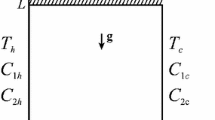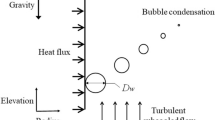Abstract
The present paper describes a detailed qualitative and quantitative study of the impacts of the overall Prandtl number on the wall-to-fluid thermal transfer mechanisms in two-phase flows using CFD. The physical model consisted of a bubble inside a cubic cavity subjected to the gravity acceleration and to a non-isothermal field. The variables studied in the present investigation were the size of the bubble radius and the overall Prandtl number of flow. The variations of the overall Prandtl number of the flow and the bubble size were evaluated in order to understand their impact on the spatial mean Nusselt number using a computational fluid dynamics model. The bubble size was controlled modifying the bubbles’ initial radius in the computational simulations and the overall Prandtl number was computed according to the Prandtl number of each phase and its volume fraction. Several computational simulations were performed and the numerical model employed in these simulations were validated with previous numerical results in the literature. The present paper reported the influence of the overall Prandtl number on regulating the thermal transfer rate in the classical problem of a differentially heated cavity. According to the numerical results, the introduction of a dispersed phase in single-phase problems may increase or reduce the thermal transfer rate, depending on the overall Prandtl number. The influence of the bubble size has also played an important role in the variations of the thermal transfer rate, since the bubble movement in the domain was modified according to to the size of this radius, changing the distance between the walls and the dispersed phase. Finally, the generally accepted hypothesis elaborated from the literature regarding the increase of the thermal transfer rate due to the introduction of bubbles in single-phase flows has failed in the cubic cavity configuration from the present research.
















Similar content being viewed by others
References
Deen, N., Kuipers, J.: Direct numerical simulation of wall-to liquid heat transfer in dispersed gas-liquid two-pahse flow using a volume of fluid approach. Chem. Eng. Sci. 102, 268–282 (2013). https://doi.org/10.1016/j.ces.2013.08.025
Deckwer, W.D.: On the mechanism of heat transfer in bubble column reactor. Chem. Eng. Sci. 92, 1341–1346 (1980). https://doi.org/10.1016/0009-2509(80)85127-X
Oresta, P., Verzicco, R., Lohse, D., Prosperetti, A.: Heat transfer mechanisms in bubbly Rayleigh-Bénard convection. Phys. Rev. 80, 259–293 (2007). https://doi.org/10.1103/PhysRevE.80.026304
Tamari, M., Nishikawa, K.: The stirring effect of bubbles upon the heat transfer to liquids. Heat Transfer – Japonese Res. 5, 31–44 (1976). https://doi.org/10.1299/kikai1938.33.87
Dabiri, S., Tryggvason, G.: Heat transfer in turbulent bubbly flow in vertical channels. Chem. Eng. Sci. 122, 106–113 (2015). https://doi.org/10.1016/j.ces.2014.09.006
Bukhari, S., Siddiqui, M.: Characteristics of air and water velocity fields during natural convection. Heat Mass Transfer 43, 415–525 (2007). https://doi.org/10.1007/s00231-005-0072-8
Chandra, A., Chhabra, R.P.: Effect of prandtl number on natural convection heat transfer from a heated semi-circular cylinder. Int. J. Mech. Aerosp. Ind. Mechatron. Manuf. Eng. 6, 106–113 (2012). https://doi.org/10.1016/j.ces.2014.09.006
Qiu, R., Wang, A., Jiang, T.: Lattice boltzmann method for natural convection with multicomponent and multiphase fluids in a two-dimensional square cavity. Canad. J. Chem. Eng. 92, 1121–1129 (2014). https://doi.org/10.1002/cjce.21950
Wan, D., Patnaik, B., Wei, G.: A new benchmark quality solution for the buoyancy-driven cavity by discrete singular convolution. Numer. Heat Transfer 40, 199–228 (2001). https://doi.org/10.1080/104077901752379620
Kizildag, D., Rodríquez, I., Oliva, A., Lehmkuhl, O.: Limits of the oberbeck-boussinesq approximation in a tall differentially heated cavity filled with water. Int. J. Heat Mass Transfer 68, 489–499 (2014). https://doi.org/10.1016/j.ijheatmasstransfer.2013.09.046
White, F.M.: Viscous Fluid Flow. McGraw-Hill (1974)
Wang, P., Zhang, Y., Guo, Z.: Numerical study of three-dimensional natural convection in a cubical cavity at high rayleigh numbers. Int. J. Heat Mass Transf. 113, 217–228 (2017). https://doi.org/10.1016/j.ijheatmasstransfer.2017.05.057
Brackbill, J.U., Kothe, D.B., Zemach, C.: A continuum method for modeling surface-tension. J. Comput. Phys. 100, 335–354 (1992). https://doi.org/10.1016/0021-9991(92)90240-Y
Chorin, A.J.: Numerical solution of the Navier–Stokes equations. Math. Comput. 22, 745–762 (1968). https://doi.org/10.1090/s0025-5718-1968-0242392-2
Centrella, J.M., Wilson, J.R.: Planar numerical cosmology. II - the difference equations and numerical tests. Astrophys. J. Suppl. Series 54, 229–249 (1984). https://doi.org/10.1086/190927
Germano, M., Piomelli, U., Moin, P., Cabot, W.H.: A dynamic subgrid-scale eddy viscosity model. Phys. Fluids A: Fluid Dyn. 3, 1760–1765 (1991)
Lilly, D.: A proposed modification of the germano subgrid-scale closure method. Phys. Fluids A: Fluid Dyn. 4, 633 (1992)
Akhtar, M., Kleis, S.: Boiling flow simulations on adaptive octree grids. Int. J. Multiphase Flow 53, 88–99 (2013). https://doi.org/10.1016/j.ijmultiphaseflow.2013.01.008
Hirt, C.W., Nichols, B.D.: Volume of fluid (vof) method for the dynamics of free boundaries. J. Comput. Phys. 39, 201–225 (1981). https://doi.org/10.1016/0021-9991(81)90145-5
Wachem, B.G.M., Schouten, J.C.: Experimental validation of 3-d lagragian vof model: Bubble shape and rise velocity. AIChE J 48, 253–282 (2002). https://doi.org/10.1002/aic.690481205
Dennner, F., Wachem, B.G.M.: Fully-coupled balanced-force vof framework for arbitrary meshes with least-squares curvature evaluation from volume fractions. Numer. Heat Transfer Part B: Fund. 65, 218–255 (2014). https://doi.org/10.1080/10407790.2013.849996
Barbi, F., Pivello, M.R., Villar, M.M., Serfaty, R., Roma, A.M., Silveira-Neto, A.: Numerical experiments of ascending bubbles for fluid dynamic force calculations. J. Braz. Soc. Mech. Sci. Eng. 40, 519–531 (2018). https://doi.org/10.1007/s40430-018-1435-7
Krane, R.J., Jessee, J.: Some detailed field measurements for a natural convection flow in a vertical square enclosure. Proc. First ASME-JSME Thermal Eng. Joint Conf. 1, 323–329 (1983)
Padilla, E., Lourenço, M., Silveira-Neto, A.: Natural convection inside cubical cavities: Numerical solutions with two boundary conditions. J. Braz. Soc. Mech. Sci. Eng. 35, 275–283 (2013). https://doi.org/10.1007/s40430-013-0033-y
Acknowledgements
The authors gratefully acknowledge financial support from Petrobras, CNPq, Fapemig and Capes. The authors are also grateful to the mechanical engineering graduate program from the Federal University of Uberlândia (UFU).
Author information
Authors and Affiliations
Corresponding author
Ethics declarations
Conflict of interests
The authors declare that they have no conflict of interest.
Additional information
Publisher’s Note
Springer Nature remains neutral with regard to jurisdictional claims in published maps and institutional affiliations.
Rights and permissions
About this article
Cite this article
de Freitas Duarte, B.A., Serfaty, R. & da Silveira Neto, A. Influence of the Prandtl Number on Wall-to-Fluid Thermal Transfer Rate in a Cubic Cavity. Flow Turbulence Combust 103, 345–367 (2019). https://doi.org/10.1007/s10494-019-00025-z
Received:
Accepted:
Published:
Issue Date:
DOI: https://doi.org/10.1007/s10494-019-00025-z




